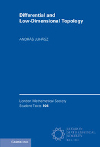- About MAA
- Membership
- MAA Publications
- Periodicals
- Blogs
- MAA Book Series
- MAA Press (an imprint of the AMS)
- MAA Notes
- MAA Reviews
- Mathematical Communication
- Information for Libraries
- Author Resources
- Advertise with MAA
- Meetings
- Competitions
- Programs
- Communities
- MAA Sections
- SIGMAA
- MAA Connect
- Students
- MAA Awards
- Awards Booklets
- Writing Awards
- Teaching Awards
- Service Awards
- Research Awards
- Lecture Awards
- Putnam Competition Individual and Team Winners
- D. E. Shaw Group AMC 8 Awards & Certificates
- Maryam Mirzakhani AMC 10 A Awards & Certificates
- Two Sigma AMC 10 B Awards & Certificates
- Jane Street AMC 12 A Awards & Certificates
- Akamai AMC 12 B Awards & Certificates
- High School Teachers
- News
You are here
Differential and Low-Dimensional Topology

Publisher:
Cambridge University Press
Publication Date:
2023
Number of Pages:
229
Format:
Hardcover
Series:
London Mathematical Society Student Texts
Price:
100.00
ISBN:
978-1009220606
Category:
Textbook
[Reviewed by , on ]
Andrew D. Hwang
07/15/2023
Differential and Low-Dimensional Topology by András Juhász is a useful guidebook written for aspiring topologists making the transition from “elementary” algebraic topology to the research frontier.
A student of topology in the 21st-century begins with algebraic invariants: homology and cohomology, the fundamental group, and higher homotopy. With these tools as the foundation, a student proceeds to learn about “classical” geometric topology of the 20th century, including CW complexes, bundles, characteristic classes, Morse theory, surgery, cobordism, and knot theory. Before reaching the research frontier, a student must generally become acquainted with tools developed since about 1980 to study three- and four-dimensional manifolds, including gauge theory, symplectic and contact structures, and geometrization of three-manifolds.
Excellent references exist for the initial stages, such as Hatcher's Algebraic Topology. For continuing students, Milnor's Topology from the Differentiable Viewpoint and Morse Theory, and Milnor and Stasheff's Characteristic Classes, remain widely-read many decades after publication.
The book under review is a slim 200+ pages, and collects in one place a wide variety of definitions, basic results, important examples, and bibliographic references a student will find helpful in the journey from beginning graduate work to topology researcher. As befits a guide, the book is neither comprehensive nor self-contained. Instead it judiciously highlights selected material and provides pointers to the literature for omitted details.
The book includes an index, and a bibliography of 180 entries spanning the works mentioned above to contemporary preprints. There are a few exercises scattered throughout, though an instructor or self-studying student will want to supplement from other sources. The writing style, again befitting a guide of this type, generally suggests an informal discussion, perhaps during afternoon tea, with a working topologist. The book should prove useful to topology students as they move into more advanced work.
After a 30-year career in academia, Andrew D. Hwang transitioned into ecommerce, founding Differential Geometry LLC to design and sell original, distinctive mathematical images and objects.
See the publisher's website.
- Log in to post comments




